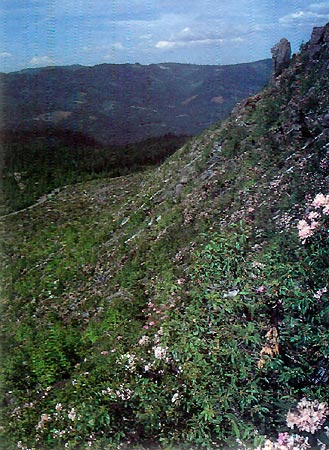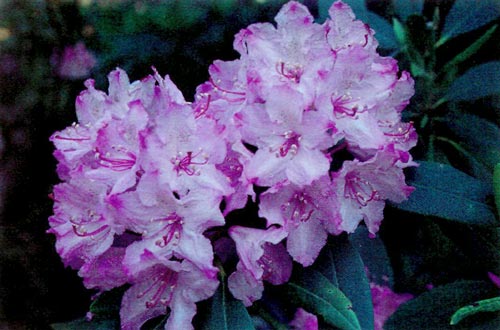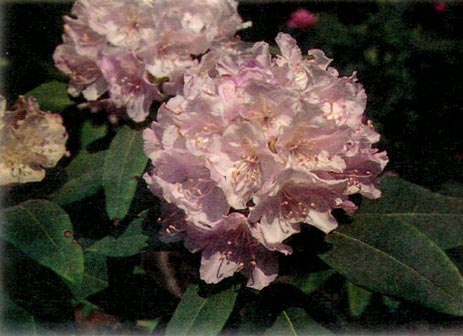JARS v40n2 - The Ross-Boge Rhododendron macrophyllum Expedition
The Ross-Boge Rhododendron macrophyllum Expedition
Dallas Boge
Gales Creek, Oregon
Reprinted from the Tualatin Valley Chapter newsletter, "The Rhody Runner".
The Beginning
The Ross-Boge expedition had its beginning in the first field trip the Tualatin Valley Chapter Study Group took to
R. albiflorum
-land in 1983. This was followed by our trip to nearby
R. macrophyllum
-land in 1984. Since that trip, Bob Ross and I had many times discussed going back and doing a more extensive search for the northwest native
R. macrophyllum
.
After the Winter 1985 American Rhododendron Society Journal came out soliciting research grant applications, Bob suggested we apply under Section No. 10 - Botanical Research. I wrote Dr. Kehr, Chairman of the Research Committee, who promptly returned an application. We filled it out and airmailed it back just before the deadline. Time dragged as we waited for the Research Committee to make its selection. Finally in May after the National Convention, word came that we had been selected.
It was time to get into high gear. Bloom time was a little more than a month away. After much looking, a trailer was located, a camp site beside Detroit Lake in the Oregon Cascade Mountains obtained, and equipment and supplies were put together.
Based on our experience of 1984, the last week of June was picked for the trip. I made a one day excursion on June 7th to check on blooming, availability of ice and propane and other consumables. There were a few blooms at 3500', but most were in bud. It looked like our timing would catch the higher plants in full bloom.

|
|
Hillside covered with
R. macrophyllum
,
Oregon Cascades Photo by Dallas Boge |
June 24th arrived and we struck out for Detroit Lake. Murphy was ahead of us somewhere, laying out surprises. Arriving at our reserved camp site, we found someone else occupying it! The park rangers found us a temporary camp site to park our trailer on as we were anxious to start expeditioning! Finally, about 11:30 a.m. we arrived at the site of last year's trip, a place of promise we intended to further explore.
Murphy had struck a mortal blow to our plans. A late frost in mid-June had turned the clear cut's blooms brown! After several systematic trips across the area, further work here was abandoned. We went looking for the 1984 marked plants, to see if they still looked as good as remembered. We found all but the plant numbered 84-5, and all with damaged blooms. I wanted to get a good picture of 84-1, our red selection, but it was denuded. Too bad, because it had bloomed heavily.

|
|
R. macrophyllum
85-1
Photo by Dallas Boge |
The Next Step
In spite of Murphy we had found and tagged three clones in the clear-cut, 85-1 thru 85-3. We found ourselves on road #515 feeling dejected about all the frozen blooms. Serendipity persuaded us to walk along the skid roads in the woods paralleling #515 on our way back to our pickups. While walking along one road Bob exclaimed, "Look at the size of that truss!" It became 85-4, the largest truss we were to see, with 29 2½" flowers in a full truss measuring 5½" tall by 6" wide. It proved to be one of the major finds of our expedition.

|
|
R. macrophyllum
85-4
Photo by Dallas Boge |
Tuesday, Paul Taylor was expected to visit so we decided to explore both sides of road #2233 (the road to R. albiflorum —land) east of road #515. Although both sides are wooded, a cleared strip 50 to 100' wide contains blooming rhododendrons. 85-5 featured corolla lobes which curved clear around to the calyx. 85-7 has 18 3" flowers of medium pink with many large brown spots. After Paul's visit we went down road #515 to Boulder Creek and worked our way down the south side thru the woods and 10' high R. macrophyllum . We did find two with a nice picotee. After a couple of hours we began to appreciate Dave Leech's definition of R. macrophyllum as "the predominant brush species of the Detroit Ranger District." (This Dave Leech is a ranger working for the Detroit Ranger District who is very knowledgeable about the species locations.) We found a skid road leading back to our road, took it and discovered a major drift of 2 to 3 year old seedlings. These were later thinned for rootstock.

|
|
R. macrophyllum
85-12
Photo by Dallas Boge |
The next day we decided to spend some time along road #620. Our first find, 85-12, had a yellow-gold blotch (a fusion of the spots). 85-13 proved to be another milestone with its medium pink rim fading to near white in the throat and numerous golden brown spots. When I knelt down to take a close-up and looked thru the pentaprism, I remarked, "This will knock their sox off!" 85-14 proved interesting because two of its stamens are petaloid. Working our way back to the pickups for lunch we came upon 85-15, the darkest pink we were to find. After lunch we found the palest pink yet found in 85-16.
We looked around road #620 further but, unable to find promising territory, we decided to look nearer Breitenbush. After refueling, we headed into the hills to try to find a clear cut not destroyed by frost. Finally along road #2231 (Boulder Ridge Road) we found a large hillside in pretty good shape. This hillside had a very high percentage of pale pink flowers. We found a couple of very pale pink clones 85-19 & 85-20, one with green-gold spotting, the other yellow-gold. Both bud pale pink, open very pale and fade quickly to white.

|
|
R. macrophyllum
85-21
Photo by Dallas Boge |
The Continuing Saga
Thursday morning our spirits were considerably higher in anticipation of exploring a nearly 500 acre clear-cut. 85-21, our first find of the day, turned out to be the best white we were to find. With 16 2¾" flowers per truss, it made a nice full truss. There was only a faint pink in the newly opened trusses, and no pink at all in the stigma and stamens.

|
|
R. macrophyllum
85-22
Photo by Dallas Boge |
Nearby we located 85-22, quite pale pink with numerous gold spots and rose stigma and stamens. With 11 to 13 3" flowers the truss measured 7" across and 5" high. 85-23 proved to be a typical R. macrophyllum , except that it showed no discernable fading from first opening to flower drop. It was growing in full sun.
Serendipity struck again. We decided after lunch to walk down road #2231 and check some other nearby areas. We hadn't gone far when an old logging road beckoned us into the woods. About 150' in we found 85-24, very pale pink with yellow-green spotting, red stigma and white stamens; all in all quite lovely. A short distance away was 85-25, with orchid pink rim and a nearly white throat. The stigma was dark rose, the stamens matching the flowers.

|
|
R. macrophyllum
85-8
Photo by Dallas Boge |

|
|
R. macrophyllum
85-6
Photo by Dallas Boge |
Friday morning we struck camp and hauled the trailer up near where we had been the day before. We went up on the ridge top to an elevation of about 4100', the highest we found R. macrophyllum . 85-26 was a typical R. macrophyllum except for the distinct white ray central to each lobe. 85-27 proved to be quite interesting. It had the darkest coloring we had seen around the rim, (the truss was just opening, it may fade), a pale throat with gold-brown spotting and 6 lobes. We really wanted to see that plant again in a few days. But that was not possible. After lunch we decided to explore behind the trailer. We located 85-28 with orchid pink rim, pale throat and heavy dark brown spotting. With 16 2¾" flowers, the truss was quite large. The plant tends to bud heavily.
We had had certain goals that we were trying to achieve. One was to find a good red flower, another a spotless flower, another a flower with red spots, still another a 3¼" or larger flower. 85-29 came close to having almost no spots but what it did have were red! Oh well, next year is another year!
First Year Conclusion
Late August saw Paul Taylor and I return to our area of exploration. We intended to collect a few more cuttings of certain clones to try rooting again. (The earlier rooting did not work out.) In addition, we wanted to collect more seedlings for future rootstock. Most people I have talked to feel that in the long run the grafts of
R. macrophyllum
are more compatible when grafted to
R. macrophyllum
rootstock.
We were able to relocate and get cuttings from 85-4, -24, -25, -28, -29. For future rootstock, we were able to bring back about 200 seedlings.
On one of his many trips across the North Santiam Highway, Paul stopped in late September to collect seed from 85-4, as well as two similar adjacent plants. We observed in June that the plants surrounding 85-4 also had large, many-flowered trusses very similar to 85-4.
Bob Ross and I returned for the last 1985 trip on October 9th. The graft of 85-27 had failed and since it was rated "high" on our informal horticultural value list, we wanted to re-collect it for another try. Since our location description was vague, it took a while to relocate it, but we did eventually. We could not find a prominent permanent marker to reference to, so we added a rock to a stump for a marker. It would be nice to see this plant in full bloom next year. We also took seed from this, as well as nearby 85-24, -25, -28, -29.
We then left Boulder Ridge and returned to the Boulder Creek area and collected seed from 85-4. While we were nearby, we went out and collected cuttings of 84-1, our red selection from a year ago. Since it had been frosted while in bloom, there was no seed. Also, there were no bloom buds on the plant. We won't see that plant bloom again until at least 1987.
After lunch we drove up to Triangulation Peak and collected seed from the R. albiflorum . We had achieved all we planned to do that day and still had quite a bit of time. We decided to relocate 85-13, one of the best found, but the location information was skimpy. After considerable looking, it was relocated and several more references to monuments made, making it much easier to locate in the future.
While there we collected seed from 85-12, -13, -15. Heading back down McCoy Creek Rd., we stopped at some of the lower elevation R. macrophyllum drifts to check bloom bud set. Bob came across a plant with oblanceolate leaves, the widest point being ¾ of the way to the tip. It was collected as 85-30. It is in an area we intend to explore in 1986, so maybe then we will see it bloom. Such was the end of the 1985 Ross-Boge Rhododendron macrophyllum Expedition.
Dallas Boge and Bob Ross are both active members of the Tualatin Valley Chapter. Dallas Boge is currently serving as Chapter President; Bob Ross is Chairman of the Chapter's Jenkins Estate Garden Committee.
